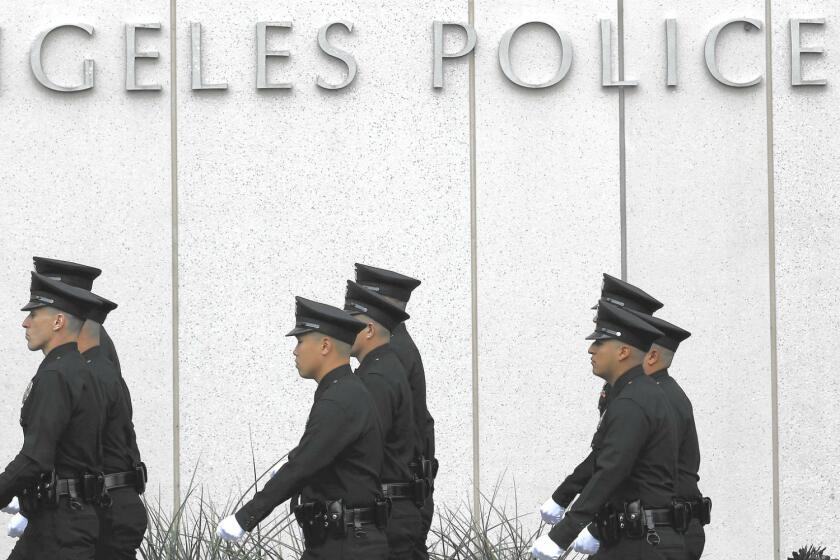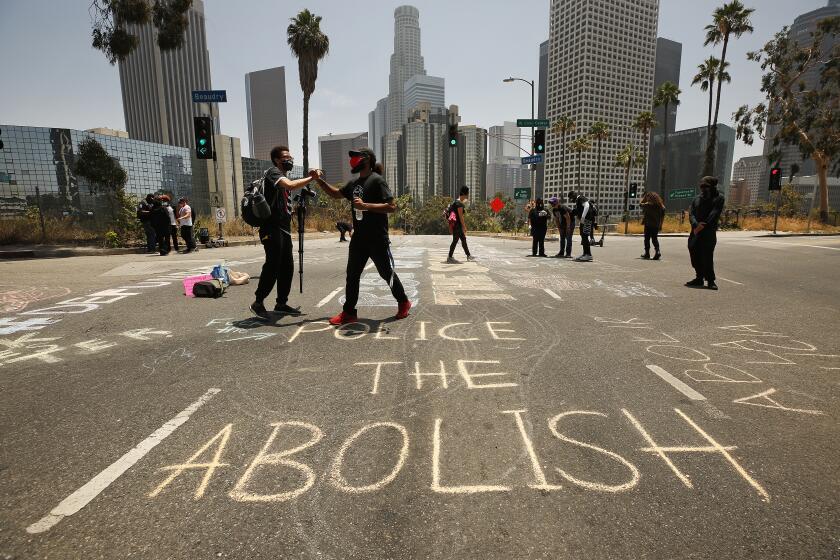Editorial: What do we do about sheriff gangs?

- Share via
Anyone expecting the Rand Corp.’s report on the Los Angeles County Sheriff’s Department to provide a last-word, full accounting of deputy “subgroups” (or gangs, cliques, frats, etc.), including membership rosters and complete catalogues of improper conduct, was in for a disappointment.
The report, released Friday after a multiyear study, has no such details but confirmed something that anyone familiar with the issue already knows: Secret deputy groups do exist and they have their own rules and rosters, independent of department command. And the report said that cliques were probably growing, despite Sheriff Alex Villanueva’s varying assertions that there are no such groups, and if there are, they were just “social groups.” And if they were more than that, he has stamped them out, and if he hasn’t, then he has made it clear that he has zero tolerance for deputies joining.
Besides, Villanueva has said, any misconduct is a result of intergenerational rivalry between training officers and trainees, and any harm they have caused has been internal, among the ranks, and not perpetrated against any members of the public.
“You can save yourself a lot of money on your studies,” Villanueva told the sheriff Citizens Oversight Commission in 2019, “because that is going to be the conclusion of the whole thing. This is hazing run amok.”
A new study finds that 16% of L.A. County Sheriff’s deputies and supervisors said in an anonymous survey they’ve been asked to join a secret clique.
Let’s just suppose for a moment that deputy subgroups really are merely a bunch of fraternities that engage in hazing run amok and not, as has been repeatedly alleged in lawsuits, gangs that encourage and reward excessive force including fatal shootings as initiation rites. Let’s suppose that secret but known organizations within the department like the Banditos and the Executioners really are just social groups who reward designated insiders with the best assignments and opportunities for advancement.
That leaves us, even in that best-possible-case scenario, with a parallel, secret and unofficial but armed and publicly paid law enforcement organization asserting its own sort of supervision, assignment and promotion, unaccountable to the official chain of command and, therefore, unaccountable to the people they serve.
The existence of such an alternative structure is simply intolerable.
The Rand study focuses on organizational behavior and culture, and it recommends adjustments like improving communication. But with all due respect to Rand’s management expertise, Los Angeles County has been down incremental roads for at least three decades, amid repeated warnings from commissions and investigators but with precious little corrective action.
The kind of change needed in the L.A. County Sheriff’s Department will not come without significant outside pressure. How much pressure? Censure from the Board of Supervisors and a litany of reports won’t do it. Nor will all those lawsuits and all those millions paid to people who said they were victimized by deputy gangs. Nor, apparently, will criminal prosecutions, given that putting Sheriff Lee Baca, Undersheriff Paul Tanaka, and numerous other sheriff’s personnel in federal prison has not meaningfully changed department culture.
The California Legislature has encountered steep resistance to the most basic form of standard-setting for police: Decertification. It’s time for cops to drop their opposition.
More radical overhauls are needed. Let’s call one option reverse-Camden — meaning Camden, N.J., where deep institutional problems with the police department in that city led to abolishing the agency, scrapping union contracts and in 2013 creating a new county-wide law enforcement department unburdened by the same legacy of failure and corrupt culture. L.A. County should look at going the other way, eliminating the Sheriff’s Department from its patrol function and creating one or more new county police departments. The sheriff would continue to supervise the jails, as required under current state law. Supervisor Sheila Kuehl has broached a very similar idea.
Another is the Rampart option — following in the footsteps of the federal consent decree that helped break the culture of the Los Angeles Police Department and put it back together again in the early part of this century. The U.S. Dept. of Justice lamentably backed off its intervention in local police departments during the Trump presidency but it is back in business and ought to consider the Sheriff’s Department, given its long history of civil rights violations and failed reform attempts.
One response to George Floyd’s death was rejection of police reform, which, opponents argued, only perpetuates a racist system. Still, reform is needed.
And there is the sheriff’s election, with the primary just nine months away. Voters ought to demand that candidates set forth clearly their positions on the reverse-Camden and Rampart options, and spell out their own — and explain why they should expect any patience from an electorate that continues to pay so much of its money ($55 million since 1990, and counting) for the improper and outrageous actions of its deputy sheriffs.
More to Read
A cure for the common opinion
Get thought-provoking perspectives with our weekly newsletter.
You may occasionally receive promotional content from the Los Angeles Times.













